PROSECCO DOC i DOCG
Producing Area And Denomination
Prosecco originally was the name of a grape, a white grape, also known as Glera. The origin of this grape is uncertain but it is present in north of Italy since 18th century.
Prosecco in the last 20 years became one of the most famous Italian wine all over the world, but also one of the most copied ones. Since Prosecco was the name of the grape, some producers from outside Europe started to cultivate Prosecco grapes to produce wines and sell it with Prosecco name on label. But Prosecco is Prosecco because this grape found his perfect habitat in north east of Italy, in Treviso province (50 km to Venice). Those wines from outside Europe were so bad that Prosecco producers saw them as a threat for reputation of Prosecco name.
So, starting from 2009 harvest the consortium of Prosecco producers decided to change the name of the grape, taking the other name of the grape, Glera, and Prosecco became the denomination of the wine produced with Glera grapes in the area allowed by consortium. In this way, can be labeled as Prosecco only wines produced in Treviso region.
Wines coming from Treviso region have a DOC (denomination of controlled origin) mark. So the complete name is PROSECCO TREVISO DOC. Inside that area there is a smallest region with 15 villages and about 10,750 acres of vineyards. This region is limited by 2 villages: Valdobbiadene and Conegliano, and is plenty of hills. Wines coming from that small area have a DOCG (controlled and guaranteed origin denomination) mark, and are the best Prosecco wines. (notice that in Italy wines with DOCG mark are less than 50). Prosecco wines coming from here can be called CONEGLIANO VALDOBBIADENE PROSECCO SUPERIORE DOGC, or just VALDOBBIADENE PROSECCO SUPERIORE DOCG . From a small cru called Cartizze, in the heart of the DOCG production zone in Valdobbiadene, an optimal geo-climatic combination produces a spumante of superlative quality: Cartizze, a real jewel of Italian enology, featuring a semi-sweet, dense taste.
.
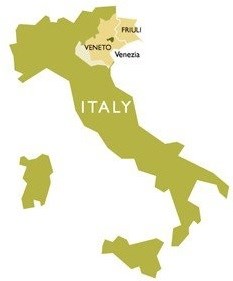
Veneto region
.
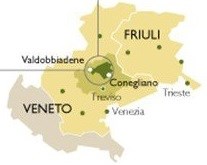
The area where Prosecco can be produced
.
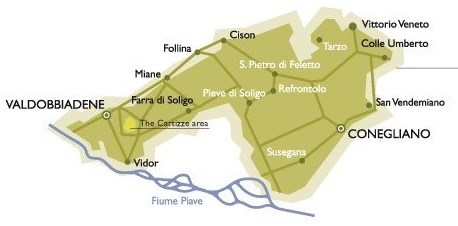
The DOCG area from Valdobbiadene to Conegliano
.
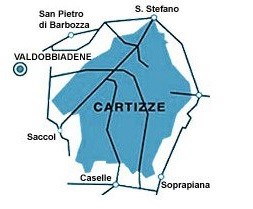
The Sub-zone Cartizze
.
The terrain is difficult to cultivate. It’s plenty of hills. Notice that to produce wine in flat lands it’s necessary 100 hours/man for 1 hectare (1 hectare is 100m x 100m). while to produce wine on hills it’s necessary 700 hours/man for 1 hectare. But in the hills wine is usually better, thanks to the wind and the highest gap of temperatures between day and night.
A fundamental role was played in the shaping of local vine-growing methods, by the founding of Italy’s first-ever Oenological School in Conegliano (school of wine making), which is still very much operative today. Notice that in the ‘conegliano – valdobbiadene’ area there is the highest density of population in the world who work with wine.
Production of Prosecco
The best way to use Prosecco grapes is to make it sparkling. There are 2 different kind of PROSECCO sparkling wines, according to the quality of the wine and to the pressure of the gas in the bottle.
- Vino frizzante (semi-sparkling or slightly effervescent) is the lowest quality sparkling wine, the pressure inside the bottle is less than 3 bar (usually from 2 to 2.5) and bubbles are bigger and irregular.
- Vino spumante is the best quality sparkling wine, the pressure is higher than 3.5 bar (usually around 5). Bubbles are smaller and more regular while rising in the surface. Only Italian sparkling wine can be called SPUMANTE. No other countries can call their wine SPUMANTE. This word reminds the Italian word SPUMA which is foam in drinkable liquids.
Glera grape gives the wine of Conegliano Valdobbiadene its basic structure (and the minimum percentage of this grape in Prosecco wine is 85%). but small proportions of Verdiso, Perera and Bianchetta, local varieties that are considered as minor, may also be used.
Right after the grapes harvest, the first stage to obtain Prosecco wine is pressing, carried out using sophisticated machinery that acts on the grapes in a gentle manner, thus extracting only the free-run juice, which comes from the heart of each berry. From 100 kilograms of grapes one can obtain a maximum of 70 litres of wine.
Then the must starts to become wine thanks to natural yeasts which, added to the must, start off the alcoholic fermentation (first fermentation). This lasts for 15–20 days in stainless steel at a constant temperature of 18°-20° C. At the end of this first fermentation one obtains the base wine.
Than starts the work of the wine maker who blend together, after a careful tasting, the various parcels of wine that are available in the winery. These wines, which until this moment have been kept separate according to their origin, date of harvest and organoleptic properties, are mixed together in very precise proportions.
Then wine is made sparkling, According to the rules of the DOC (Treviso) and DOCG (Conegliano-Valdobbiadene), Prosecco sparkling wine can be produced either with traditional method or with Charmat-Martinotti method (also known as Italian method). But the bottles of Prosecco produced with the traditional method are only a few, as experimental products. That’s because the Charmat-Martinotti method allows to preserve the grapes’ varietal aromas, giving a fruity and floral wine.
According to Charmat-Martinotti method, the wine is put into large pressurized tanks together with sugar and yeasts for at least 30 days. This second fermentation produces CO₂ or, in other words, the silky bubbles that are characteristic of Conegliano Valdobbiadene.
Once the wine is sparkling, bottling takes place and, after 30-40 days, the wine is ready to be released onto the market.
.

.
.
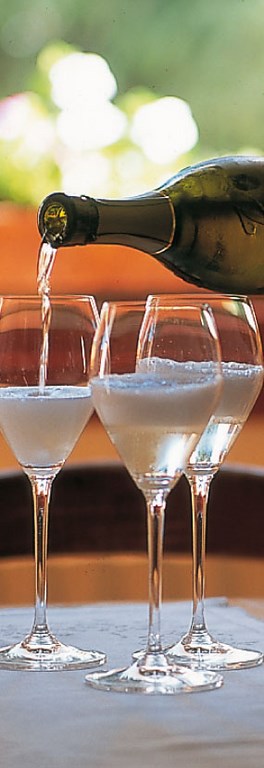
.
Cocktails with Prosecco
Cocktails Prosecco based, explained by Jamie Oliver




